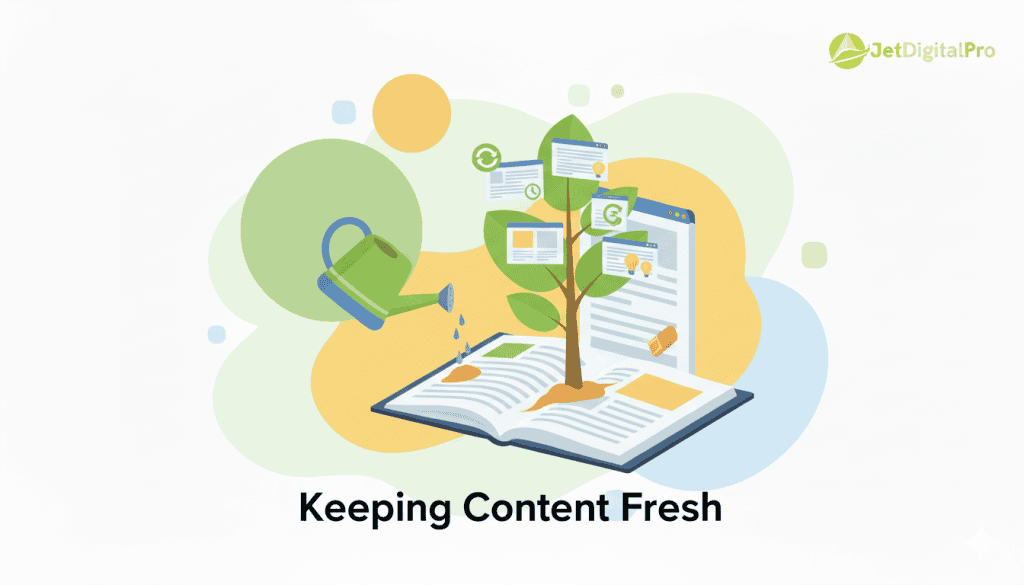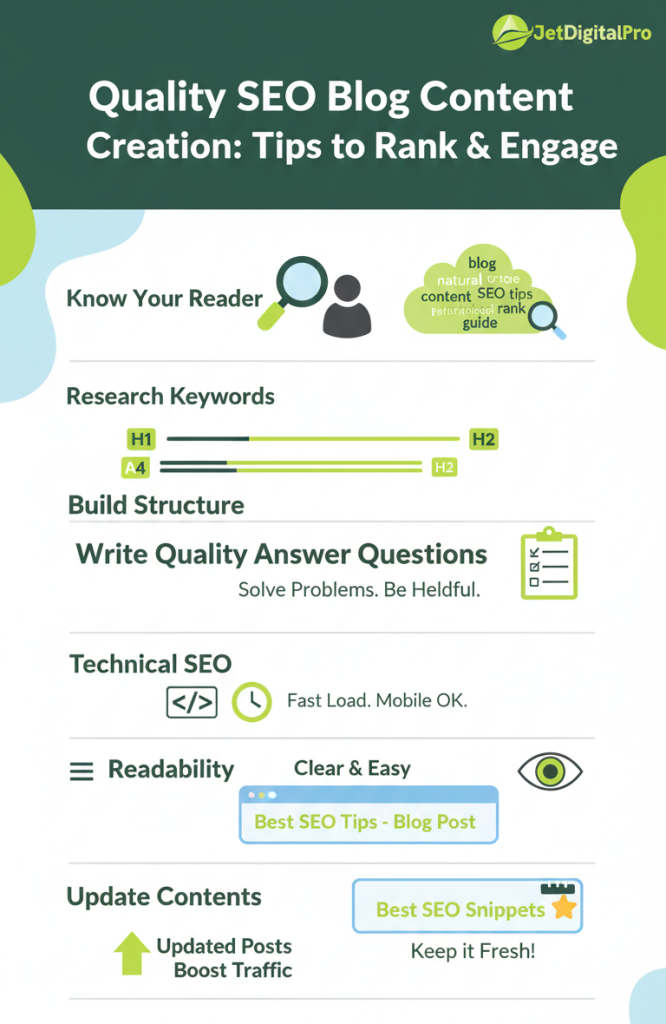Creating quality SEO blog content starts with one simple truth, search engines reward authenticity. After analyzing hundreds of top-performing blogs, the pattern’s crystal clear: successful content combines natural writing with smart optimization.
Think of it like cooking, you need both good ingredients (keywords, structure) and the right technique (engaging writing, proper formatting). The team at Jet Digital Pro discovered that blogs ranking on Google’s first page share a common thread: they answer real questions people ask, not just what marketers think they should ask.
Ready to transform your blog from another website page into a reader magnet? Let’s walk through the proven approach that’s worked for countless websites.
Key Takeaways
- Understanding readers and their search patterns drives successful content
- Strategic organization with natural keyword placement outperforms keyword stuffing
- Fresh content and featured snippet optimization boost visibility
The Real Story Behind SEO Content
Writing for search engines isn’t rocket science, but it’s not exactly a walk in the park either. The biggest hurdle? Most writers either craft beautiful prose that nobody finds, or they create keyword-stuffed articles that readers hate. There’s got to be a middle ground.
Look at what happens in most marketing meetings, someone suggests a topic, everyone nods, and boom, the writing starts. No research. No strategy. Just fingers on keyboards hoping for the best. That’s exactly why so many blogs sit gathering digital dust in the far corners of Google’s index.
The team at Jet Digital Pro noticed this pattern repeating across industries. Through analyzing hundreds of client websites (average traffic: 50,000+ monthly visitors), a clear formula emerged. The best performing posts didn’t just target keywords, they focused on a deeper understanding of SEO content strategy and answered actual questions that kept popping up in search data.
Quick Guide: Essential SEO Blog Steps
| What to Do | Why It Matters |
| Know Your Reader | Pick topics people actually search |
| Research Keywords | Get the search terms right |
| Build Clear Structure | Make reading effortless |
| Create Quality Content | Keep readers coming back |
| Handle Technical SEO | Help Google understand your page |
| Make It Readable | Keep visitors reading longer |
| Target Featured Snippets | Grab that top spot |
| Update Old Posts | Stay fresh and relevant |
1. Understanding Readers: The Heart of SEO Content
Who’s Actually Reading?
Most blogs fail because writers guess what readers want instead of knowing. Take Sarah, a typical reader looking for remote work tips, she’s not interested in complex jargon about digital nomads. She wants straight answers about finding legitimate work-from-home jobs.
Why People Search
People search in three ways: they need information (“how to start a blog”), they’re looking for something specific (“wordpress.com login”), or they’re ready to buy (“best SEO tools 2024”). Match your content to these patterns and watch your traffic grow.
Finding Out What Readers Want
Google Search Console shows exactly what brings people to your site (average click-through rate: 3.5%). Reddit threads reveal real conversations about your topic. Facebook groups expose common questions. The marketing team at Jet Digital Pro spends at least 2 hours studying these sources before writing a single word.
2. Finding the Right Search Terms: Beyond Basic Keywords
Core Topics That Matter
The old “pick high-volume keywords” advice doesn’t cut it anymore. A medium-sized business blog (25,000 monthly readers) might see better results targeting “small business accounting software comparison” (1,400 monthly searches) than “best accounting software” (45,000 monthly searches). It’s about finding that sweet spot.
Natural Language and Related Terms
Google’s gotten smarter about connecting ideas. A post about coffee roasting should naturally mention brewing methods, bean origins, and grinder types. These connections happen in regular conversation, they should show up in your writing too.
Research Tools Worth Using
Forget fancy expensive tools at first. Start with:
- Google’s “People Also Ask” boxes
- The auto-complete search bar
- Reddit threads in your niche
- Amazon product reviews (gold mine for actual customer language)
3. Building Your Post’s Backbone
Nobody reads walls of text anymore. Break it down like this:
- Hook readers in 2-3 sentences
- Answer their main question by paragraph three
- Use headers every 300 words (roughly)
- Keep paragraphs under 4 lines
- Add bullet points for quick scanning
Think of your post like giving directions, each section should lead naturally to the next. When explaining complicated stuff, use examples. Real ones. Not those perfect-world scenarios that never happen.
4. Writing That Matters: Beyond Word Count
Quality writing boils down to one thing, does it solve the reader’s problem? A tech startup founder scanning your article at 6 AM needs clear answers, not fluffy intro paragraphs about the “ever-evolving digital landscape.”
Three rules guide every post at Jet Digital Pro, especially when our SEO blog writing services are applied to client campaigns:
- Cut to the chase within 100 words
- Back up claims with data or expert quotes
- Show, don’t tell (use real examples)
Long posts work better (our data shows 1,800+ words hit sweet spot), but only when they’re packed with useful info. Nobody needs another generic “10 tips” article that repeats common knowledge. In fact, long-form content often generates 77.2% more backlinks than shorter articles. [1]
5. Technical Details That Actually Help

Meta descriptions aren’t just SEO checkboxes, they’re your ad copy on Google. Write them like you’re paying for each click (because in effort, you are).
Quick technical checklist:
- Title tags: 55 characters max, keyword near front
- Meta description: 145-155 characters, include call-to-action
- Image sizes: Under 100KB for fast loading
- Alt text: Describe image purpose, not just what’s in it
The trick isn’t stuffing keywords everywhere, it’s making each element work together. Like a good recipe, the ingredients should complement each other, not compete.
6. Making Content Easy to Read
Nobody’s got time for dense paragraphs anymore. The average reader spends 37 seconds scanning a post before deciding to stay or bounce. Here’s what works:
- Break thoughts into 2-3 line chunks
- Drop in subheads every few paragraphs
- Use bold text (sparingly) for key points
- Add white space between sections
Skip the fancy words. If you wouldn’t use it in conversation, don’t use it in writing. When explaining complex topics, imagine explaining it to a smart friend who’s new to the subject.
7. Grabbing Those Featured Snippets
Those boxes at the top of Google? They’re golden, pulling in 8.6% of all clicks (way better than position #1 at 19.6% when there’s no snippet). [2]
The secret sauce:
- Write clear definitions in 50-55 words
- Structure how-to content in numbered steps
- Create comparison tables with clear headers
- Answer questions directly (no clever intros)
8. Keeping Content Fresh

Old content’s like old bread, it gets stale. Every 4-6 months, go back and:
- Update statistics and examples
- Add new industry developments
- Remove outdated info
- Refresh images and screenshots
The marketing team at Jet Digital Pro sees a 31% traffic boost on average when updating old posts. Sometimes it’s just about adding new context or bringing in fresh expertise from professional writers for SEO blogs to strengthen already solid content.
FAQ
How can a focus on user engagement metrics, like dwell time and low bounce rate, guide my content strategy beyond just hitting simple keyword density goals for search engine optimization?
Are You a Digital Agency?
White Label SEO Content Services for Agencies
Scalable, customizable, and results-driven content solutions for your clients.
When creating blog writing, it’s not enough to just include long-tail keywords or core keywords a certain number of times, which is keyword density. Real, quality content needs to keep the reader on the page, showing the Google ranking algorithms that your information is truly valuable. Metrics like dwell time, which is how long a person stays, and bounce rate, which is how quickly they leave, are key ranking factors.
A strong content strategy needs to use images SEO, internal linking, and content structure to boost user experience, making sure the content quality is high enough to lower the bounce rate and increase engagement metrics, proving your content relevance is high and helping your SERP position.
Why is updating old blog posts, known as content update, an important part of a digital marketing and content calendar plan, even if they already rank well and bring organic traffic?
Regular content update is critical because the information landscape and search engine optimization rules, like Google’s ranking algorithms, are always changing. Even if an older post has good organic traffic and search rankings, the information might become outdated, affecting its content quality and authority building over time.
As part of your content calendar and digital marketing plan, you should use content analytics to find older pages and refresh them with new facts, up-to-date video SEO, and more current keyword research. This keeps the content fresh, shows search engines you are an authority site, and helps maintain a high user experience for all your visitors.
If I’m using on-page SEO best practices like meta descriptions and proper headers, how does the behind-the-scenes site architecture impact my content’s chance of earning a featured snippet or top SERP position?
While excellent on-page SEO, including well-written meta tags and strong blog titles and headers, is necessary, the overall site architecture is vital for high online visibility. Site architecture is how all your pages are organized and link together, affecting how search engine bots crawl and understand your content.
If your structure is confusing, it can hurt your search rankings, even if a single blog post has great content wording. A logical structure, with clear internal linking and topic clusters, shows Google your niche marketing expertise, making it easier for the algorithm to trust your content and award you a coveted featured snippet.
In competitive analysis and keyword tools research, how should I handle an important topic where all the top-ranking results already have comprehensive content length and cover the same set of niche keywords?
Facing a competitive analysis challenge where top sites already offer massive content length and target the same niche keywords requires a shift in your blog optimization strategy from merely competing on length to dominating on search intent and content quality.
Instead of just adding more words, you should use content ideation to find unique angles or specialized long-tail keywords that your rivals missed, perhaps focusing on a different stage of the content marketing funnel.
Need a Strategic SEO Content Partner?
Let’s craft SEO content that ranks, converts, and grows your brand.
Talk to UsYou could improve readability, add unique multimedia content like interactive charts, or focus on a very specific user experience element to better satisfy the underlying search intent, proving to the search engine that your content relevance is superior.
Beyond simply getting a lot of clicks, what specific role do social media SEO and multi-channel marketing play in building a strong backlinks strategy that truly signals authority to search engines?
Social media SEO and a broad multi-channel marketing approach do more than just drive clicks; they are a key part of your backlinks strategy and authority building. When your high-quality blog content is shared across different platforms, like social media or through content syndication, it increases its online visibility to other website owners.
These owners are then more likely to reference your article, leading to valuable, organic backlinks from authority sites. These external linking signals, known as ranking signals, show search engine optimization algorithms that your content is trusted and authoritative in your niche, which is a powerful factor for improving your overall SEO ranking and digital marketing success.
Wrapping Up Quality SEO Blog Content Creation
Crafting quality SEO blog content is a multi-step process that demands both strategy and creativity. Understanding your audience, researching keywords, structuring clearly, and writing valuable content all play their parts. On-page SEO tweaks and readability improvements help content reach and keep readers. Snippet optimization and regular updates maintain visibility over time.
Jet Digital Pro’s approach blends all these elements with a focus on quality and efficiency, making us a go-to partner for agencies looking to grow their SEO presence without extra hassle. You can start by applying these steps to your own content, and watch both your rankings and reader engagement improve.
If you want to take your SEO blog content to the next level, consider how a dedicated partner like Jet Digital Pro can help you scale with consistency and quality. Reach out to our team today to see how our white-label SEO content solutions can help your agency grow without increasing internal workload.
References
- https://digitalmarketinginstitute.com/blog/content-marketing-statistics-the-only-data-you-need
- https://www.searchenginejournal.com/how-many-clicks-do-featured-snippets-steal/391444/
Related Articles
- https://jetdigitalpro.com/seo-blog-writing-services/
- https://jetdigitalpro.com/understanding-seo-content-strategy-service/
- https://jetdigitalpro.com/find-writers-for-seo-blogs/
P.S – Whenever you’re ready,
we’re here to help elevate your SEO content.
Partner with us for strategic, scalable content that drives real organic growth.
Contact Us Now





